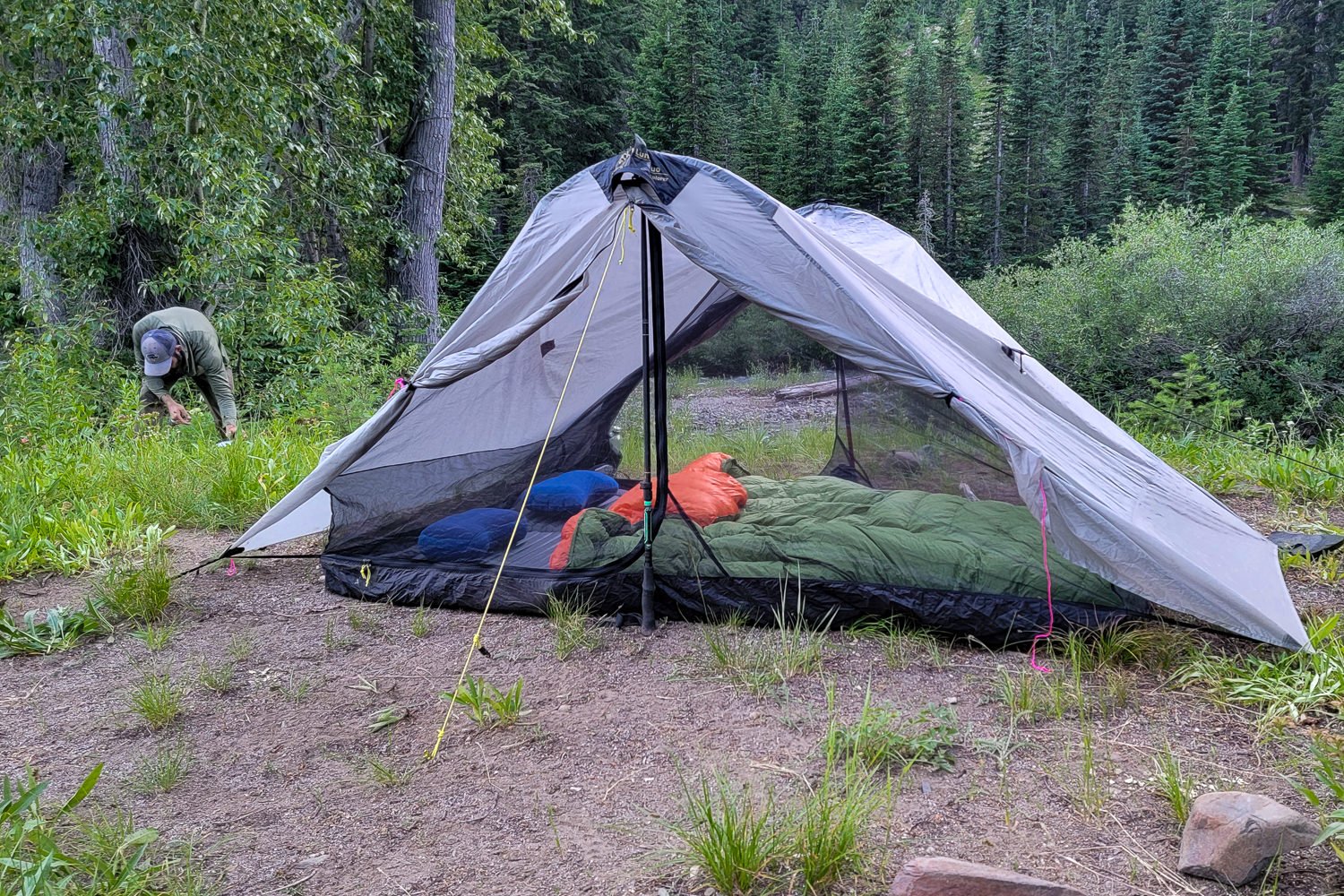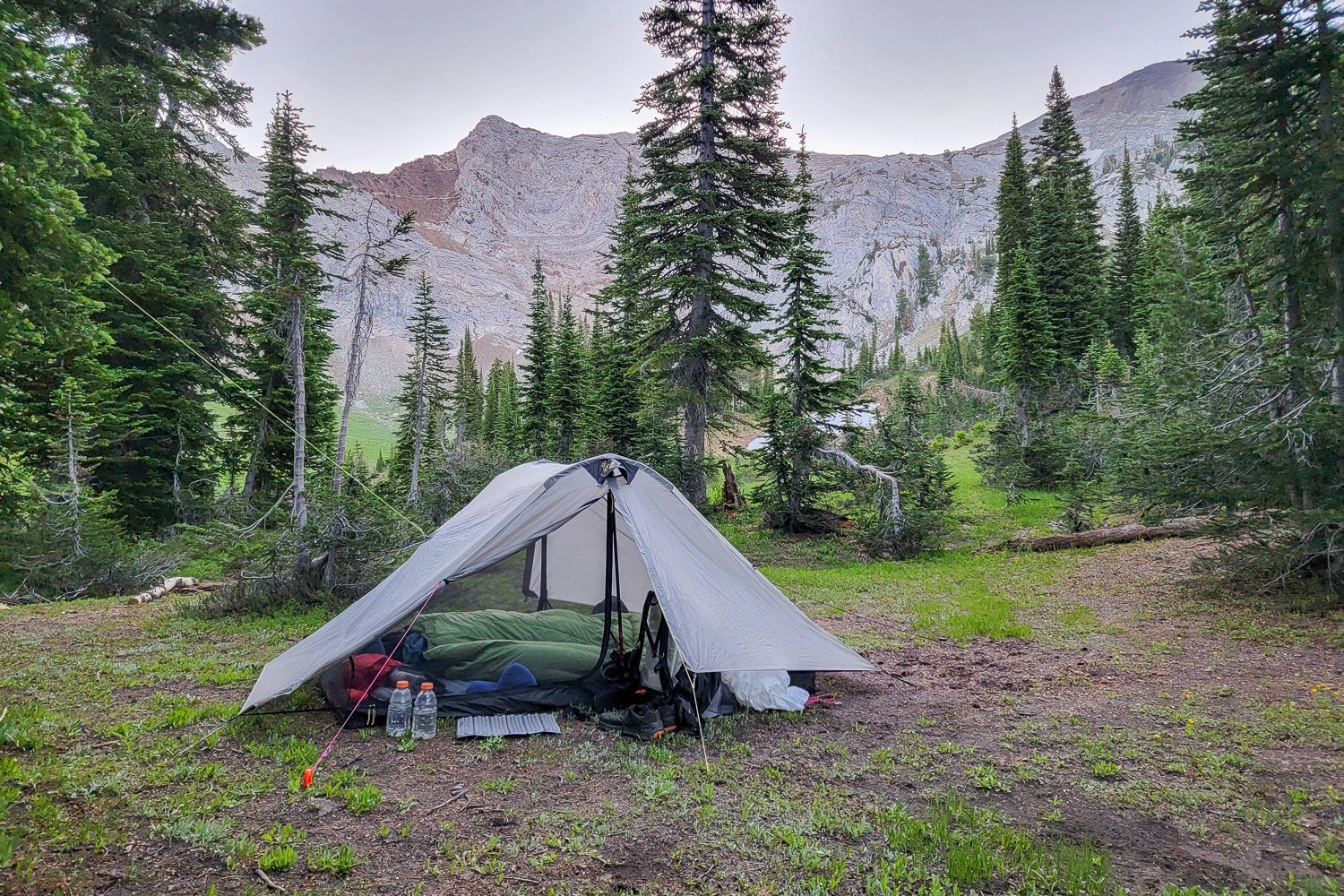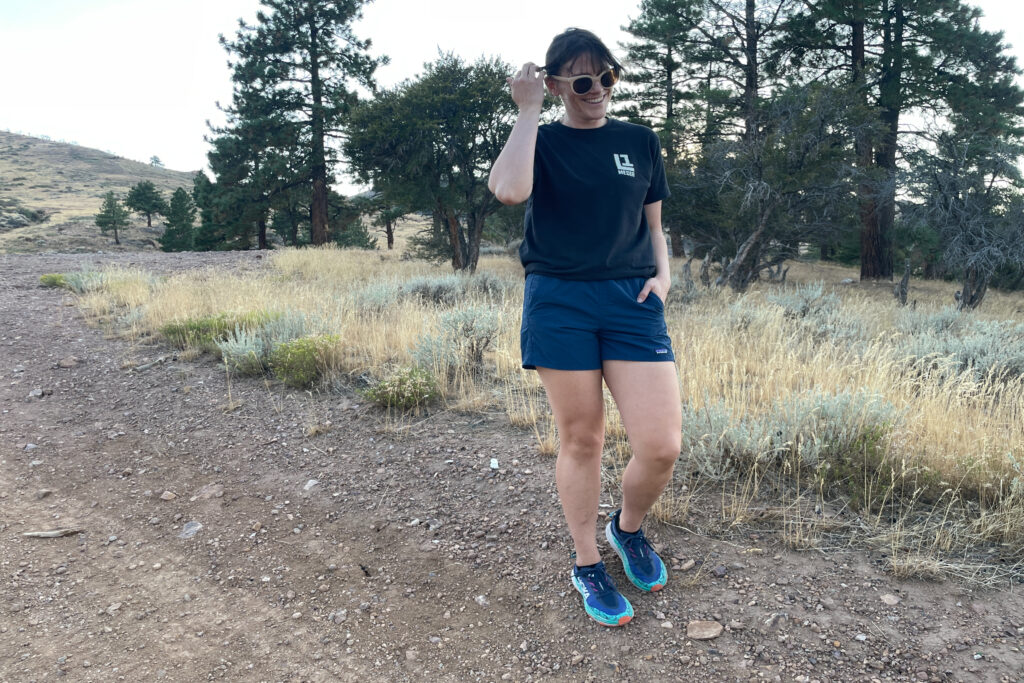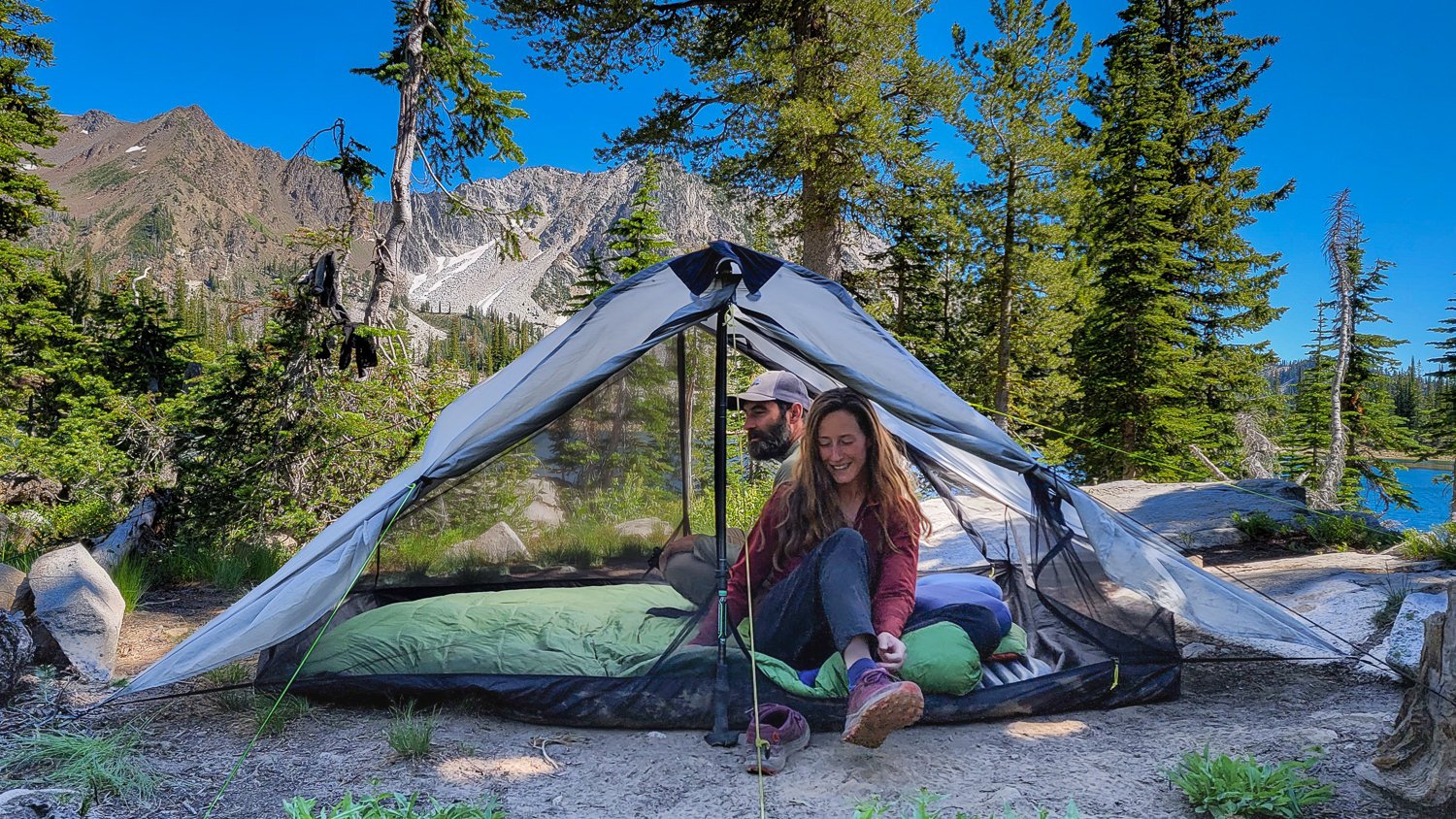
Bottom Line
The Six Moon Designs Lunar Duo stands out as a roomy, no-frills backcountry tent for budget-conscious backpacking pairs. It’s one of the most spacious tents on our best backpacking tents guide thanks to the arched brow poles, which offer a generous amount of headroom, and the expansive interior rivals much pricier models. CleverHiker Gear Analyst, Heather Eldridge, has put the Lunar Duo through the wringer on multiple thru-hikes covering thousands of miles, and it continues to hold up like a champ. Its large vestibules, efficient ventilation, and low weight make it a no-brainer for backpackers on a budget.
Since it’s a non-freestanding tent, the Lunar Duo can be challenging to pitch and manage. It’s also slightly heavier than other ultralight tents, but it’s also much easier on your wallet. The Duo is also lacking in interior organization, with only two pockets, so its livability isn’t top-tier. But, if you’re looking for a roomy ultralight shelter to keep you feeling light on your feet during the day and comfy at night – all for a super affordable price – the Six Moon Designs Lunar Duo might be exactly what you need to get into the backcountry for your next big adventure.
Quick Specs

Six Moon Designs Lunar Duo
Affordable & Spacious Ultralight Backpacking Tent
CleverHiker Rating: 73.5/100
Price: $395
Packed Weight: 2 lb. 13 oz.(no stakes or poles)
Dimensions (LxWxH): 90 x 54 x 45 in.
Type: Non-freestanding
Pros
- Spacious
- Affordable
- Ultralight
- Small packed size
- Very durable for the weight
- Ample headroom
- Excellent ventilation
- Large doors/vestibules
Cons
- Seam sealing costs extra
- Needs condensation management
- Non-freestanding design has a learning curve

Comfort
In the Lunar Duo elbow room isn’t a luxury – it’s a standard feature. With a 45-inch peak height, 7.5-foot length, and a 54-inch width that easily accommodates two wide sleeping pads, the duo has plenty of headroom for two people to move around inside simultaneously, so it’s a dream for taller hikers or those who just like extra space when camping. Two pre-bent, arched brow poles help to distribute the height evenly and prevent the tent from feeling cramped. Two large doors allow easy access for both campers, so you don’t have to crawl over each other during late-night bathroom breaks. The oversized vestibules make this tent even more comfortable, offering ample room to stash all your gear without cluttering the sleeping area. And the fully enclosed design with a built-in bathtub floor and attached mesh inner offers excellent protection from insects and critters.
However, the Lunar Duo falls into the same trap as most single-wall tents: when the weather is humid, chilly, and damp, condensation can build up on the interior of the tent, which can be uncomfortable. While it has good ventilation that minimizes this issue versus other single-wall designs, it’s something to consider depending on the climate and weather. The Duo also has limited internal organization with just two small pockets, meaning much of your gear will be on the floor while you’re inside. That said, this is an ultralight shelter meant for sleeping – not necessarily for lounging – so for weight-conscious backpackers, none of these issues are deal breakers.
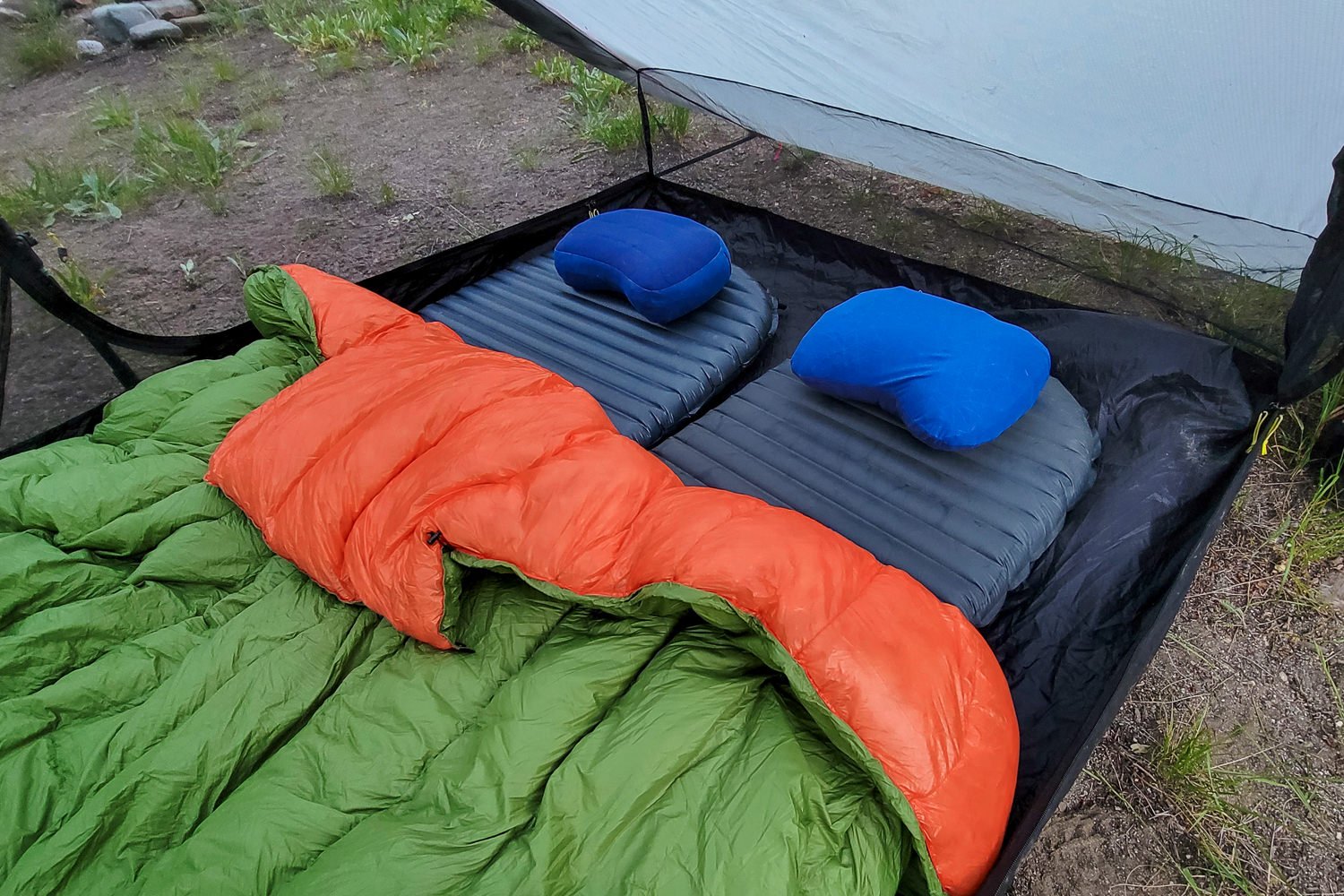
Weight & Packability
The Lunar Duo impresses with its ultralight weight of 2 pounds, 13 ounces, making it a strong contender for backpackers prioritizing a balance between weight and interior space. For a 2-person, 2-door tent, this weight is exceptionally low, especially given the spacious interior. Its minimalist design sheds unnecessary bulk, making it easy to pack and carry on long treks. The tent’s packability is further enhanced by its ability to compress into a small, manageable size that fits seamlessly into most backpacks. This means more room for other essentials without compromising shelter quality. The materials strike a good balance between weight savings and durability. Whether you’re a thru-hiker or a weekend adventurer, the Lunar Duo’s weight and packability make it a reliable companion for lightweight travel.
However, the Lunar Duo doesn’t include stakes or poles in its base weight, which adds to the overall pack load. For ultralight enthusiasts who count every ounce, this might be a drawback, especially compared to even lighter options on the market. While the tent is compact, it’s not the most streamlined or smallest-packing option available, meaning it may take up more space than some of the most elite ultralight tents. Additionally, lighter alternatives made with Dyneema Composite Fabric offer significant weight reductions but at nearly double the cost. If you’re willing to carry a bit more weight to save money, the Lunar Duo remains a great value. But for those seeking the absolute lightest gear, this tent might not be the top choice.

Weather Resistance
The Lunar Duo is reliable in wet and windy conditions. The rainfly is made from silnylon, known for its robust waterproofing in downpours. Hooded vents at the top of each door and along the lower perimeter of the tent allow for good airflow and help reduce condensation inside. The floating canopy design is versatile, so you can adjust the height for better ventilation or more protection depending on the weather. The large outer doors can be fully rolled back for better views and ventilation when conditions are clear, but also secure tightly for protection in driving rain. We’ve put the Lunar Duo through the wringer in the notoriously volatile Rocky Mountains, and it kept us dry and comfortable throughout heavy rains, hailstorms, and high winds.
The key – as with any non-freestanding tent – is to pitch it so it’s taut and secured to the ground using all guyout points. The non-freestanding design takes a bit of extra attention to setup, but when done correctly, it creates a solid barrier against harsh weather. It’s a dependable shelter that ensures a dry night’s sleep, even in the face of unpredictable mountain weather.
However, the Lunar Duo isn’t without its challenges. Keep in mind that the tent must be seam-sealed before use to be fully waterproof, a step that either costs extra or takes time and effort to do yourself. The single-wall design and small vents mean the tent is lighter but still offers decent ventilation. That said, there’s no mesh barrier between you and the rainfly, which can lead to condensation. On cold, damp nights, that means you and your gear can come into contact with the wet interior, so we highly recommend bringing along a small absorbent cloth to wipe down the tent for nights when condensation is an issue. The non-freestanding design means you’ll need to find the flattest camping spots possible and pitch the tent carefully to stand up against strong winds, a process that can be tedious in rocky and sloped terrain.

Ease of Setup
Compared to other non-freestanding tents, the Lunar Duo is relatively quick, even for beginners. In fact, we’ve seen new users pitch the Duo in only five to seven minutes, and seasoned users can cut this down to two to three, even on challenging terrain. One of the standout features of the Lunar Duo is the ability to re-tension the main guylines from inside the tent, so you can tighten your shelter without leaving the comfort of your sleeping bag. This feature is one of our favorite things about the Duo – it’s a lifesaver when silnylon sags in cold or wet conditions and you need to keep the tent tight when weather changes. Although non-freestanding tents like the Lunar Duo have a bit of a learning curve, following the setup instructions and practicing beforehand can make the process much smoother. The tent either uses trekking poles or lightweight tent poles to pitch, and the Lunar Duo’s need for only eight tent stakes makes it straightforward to secure.
However, the Lunar Duo’s non-freestanding design can be a real challenge in certain environments, especially when the ground is too hard or too soft for stakes to hold well. Keep in mind that tent stakes and poles aren’t included, so be sure to pick them up at the time of purchase. When setting up the duo in less-than ideal-spots, you may need to get creative, like using logs or rocks, to secure the tent properly. The tent also takes up more space than freestanding options, so you’ll need a larger area to pitch, which can limit where you camp. In general, the setup process for non-freestanding tents is manageable, but is never as quick or easy as with a freestanding tent, which might not suit everyone.

Durability
Among ultralight non-freestanding tents, the Lunar Duo is one of the most durable. It uses a robust 30-denier floor and thick canopy material that makes it notably tougher than many other tents that use lighter fabrics like 20 or 15-denier. The durability of the Lunar Duo means it can handle more rugged conditions, making it a solid choice for hikers with dogs or folks who are hard on their gear. The stronger material also means that using a footprint (sold separately) isn’t always necessary, so you can keep your pack lighter and more streamlined. This tent’s durability is especially reassuring on long treks, where reliable gear is crucial.
However, the durability of the Lunar Duo’s 30-denier fabric means it’s notably heavier compared to other ultralight tents – although it remains much lighter than many other options with dedicated poles. The non-freestanding design makes this tent less durable in windy conditions unless staked out meticulously, and it starts to show wear after extensive use in harsh environments, especially at the stress points and seams. However, at this price point, we think the Lunar Duo is an outstanding deal for several seasons of backpacking, even in tough conditions.

Should You Buy the Six Moons Designs Lunar Duo?
If you’re looking for a roomy, ultralight shelter at an exceptionally affordable price, there are few tents that compare to the Six Moon Designs Lunar Duo. This tent is a slam dunk for adventure seekers and pairs who want lots of space to move around without sacrificing durability – and at an unbeatable price. With its unique pre-bent brow poles that create plenty of headroom for two, expansive vestibules for storing bulky and wet gear, and relatively simple setup, the Lunar Duo turns the trail into your home away from home. This tent can handle countless miles on tough thru-hikes and is a reliable solution for almost any 3-season backpacking adventure. Its airy build and bare-bones features make it a perfect choice for those who want the basics without the weight.
On the flip side, if you’re inclined toward freestanding designs or need a more compact shelter, the Lunar Duo might not be perfect. Its non-freestanding structure demands a precise setup that can be tricky on uneven ground. The design of a single-wall tent like this is prone to condensation. And, while durable, it’s a bit heftier than some ultralight models, which may not suit solo trekkers who want the lightest load.

What Other Backpacking Tents Should You Consider?
Durston X Mid 2: Similar in size to the Lunar Duo, the Durston X-Mid 2 is a non-freestanding design with decent water resistance and durability. Though it’s even trickier to pitch, has louder material, and has a bit less headroom, the X-Mid 2 is significantly lighter and more affordable.
Zpacks Duplex Review: The Zpacks Duplex offers interior space and minimal features in a non-freestanding design, much like the Lunar Duo. However, it’s over a pound lighter and has superior weather resistance – although you’ll pay nearly twice the price for the weight savings.
Big Agnes Tiger Wall UL2 Solution Dye Review: The Tiger Wall UL2 shares the Lunar Duo’s durability and comfort, making it a solid option for solo hikers or pairs with similar needs. It’s slightly lighter, easier to set up, and has better weather resistance, but at the cost of a smaller interior and a higher price tag. We also love the Tiger Wall UL3, which is even roomier for hiking pairs.






